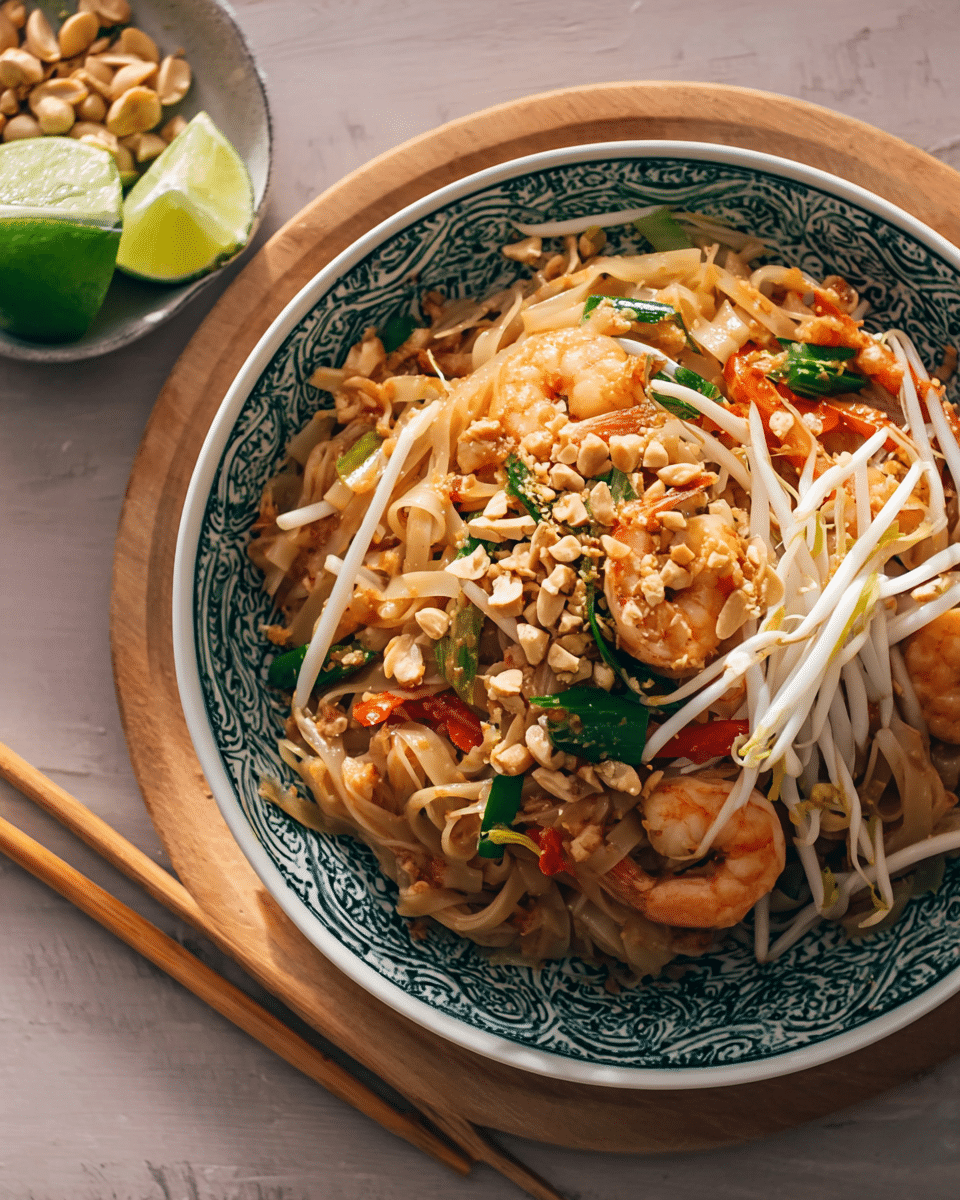Pad Thai is a quintessential Thai dish that brings together a harmonious blend of flavors and textures. The stir-fried rice noodles serve as a perfect base, absorbing the tangy tamarind sauce, salty fish sauce, and sweet sugar, creating a delightful umami profile. The addition of shrimp or tofu provides protein, while the crunchy bean sprouts and peanuts add texture and freshness. Garnished with lime wedges and chili flakes, each bite offers a balance of savory, sour, sweet, and spicy notes. This dish is not only a treat for the taste buds but also a feast for the eyes. The vibrant colors of the fresh ingredients, combined with the glossy noodles and garnishes, make Pad Thai an inviting and appetizing meal. Whether you’re cooking for yourself or entertaining guests, Pad Thai is sure to impress with its bold flavors and beautiful presentation.
Full recipe:
Ingredients:
-
8 oz (225 g) rice noodles
-
1 tablespoon vegetable oil
-
2 cloves garlic, minced
-
1 shallot, finely chopped
-
1/2 cup firm tofu, cubed
-
1/2 cup shrimp, peeled and deveined
-
2 large eggs, lightly beaten
-
1 cup bean sprouts
-
1/4 cup garlic chives, chopped
-
1/4 cup roasted peanuts, crushed
-
1 lime, cut into wedges
For the Pad Thai Sauce:
-
3 tablespoons tamarind paste
-
3 tablespoons fish sauce
-
2 tablespoons brown sugar
-
1 tablespoon oyster sauce
-
1 tablespoon lime juice
-
1 teaspoon chili flakes (optional)
Directions:
-
Prepare the noodles: Soak the rice noodles in warm water for about 30 minutes or until they are pliable but still firm. Drain and set aside.
-
Make the sauce: In a small bowl, whisk together tamarind paste, fish sauce, brown sugar, oyster sauce, lime juice, and chili flakes (if using) until the sugar dissolves. Set aside.
-
Cook the protein: Heat vegetable oil in a wok or large skillet over medium-high heat. Add the tofu and shrimp, cooking until the shrimp turns pink and the tofu is lightly browned. Remove and set aside.
-
Scramble the eggs: In the same pan, pour in the beaten eggs. Scramble until just set, then push to one side.
-
Stir-fry the aromatics: Add garlic and shallot to the pan, sautéing until fragrant.
-
Combine: Add the soaked noodles to the pan, pour the prepared sauce over them, and toss to coat evenly.
-
Add vegetables and protein: Stir in bean sprouts, garlic chives, cooked tofu, and shrimp. Toss everything together until well combined and heated through.
-
Serve: Plate the Pad Thai and garnish with crushed peanuts and lime wedges. Serve immediately.
Prep Time: 15 minutes | Cooking Time: 15 minutes | Total Time: 30 minutes
Kcal: Approximately 550 kcal per serving | Servings: 2 servings
Background of Pad Thai
Pad Thai is one of the most iconic dishes in Thai cuisine and a global favorite for its vibrant combination of flavors and textures. Originating in Thailand during the mid-20th century, this stir-fried noodle dish was popularized as part of a national campaign to promote Thai identity and culinary culture. Traditionally cooked with rice noodles, a sweet and tangy tamarind sauce, fresh vegetables, and protein like shrimp or tofu, Pad Thai embodies the perfect balance of sweet, sour, salty, and umami flavors. This dish has evolved over time, allowing chefs and home cooks to personalize it with a variety of proteins, garnishes, and spice levels, making it both versatile and widely loved.
Health Benefits of Pad Thai
Pad Thai is more than just a delicious meal—it can be a nutrient-packed dish when made with fresh ingredients. Rice noodles provide a gluten-free carbohydrate source for energy, while shrimp and tofu contribute high-quality protein essential for muscle repair and maintenance. Bean sprouts, garlic chives, and other vegetables add fiber, vitamins, and minerals that support digestion and overall health. Tamarind paste and lime juice offer antioxidants and enhance digestion, while peanuts provide heart-healthy fats. Choosing lean proteins and controlling the amount of sugar and oil in the sauce makes Pad Thai a balanced, wholesome, and satisfying meal.
Why This Recipe Stands Out
What makes this Pad Thai recipe exceptional is its authentic flavor and simple execution. Unlike restaurant versions that may be heavy on oil or sodium, this recipe emphasizes freshness and balance. The homemade tamarind-based sauce ensures a rich, tangy, and slightly sweet flavor that clings perfectly to the noodles. Fresh vegetables, lightly cooked to retain crunch, provide texture and visual appeal. Whether you choose shrimp, tofu, or a combination of both, the proteins absorb the sauce beautifully, making each bite flavorful and satisfying. This recipe is ideal for both beginners and experienced cooks seeking a quick yet authentic Thai meal at home.
Perfect Pairings and Serving Suggestions
Pad Thai is traditionally served with lime wedges, crushed peanuts, and chili flakes, allowing diners to adjust flavors to their liking. It pairs well with light Thai-style salads, fresh herbs like cilantro or Thai basil, and a side of steamed or fried vegetables. For a heartier meal, consider adding a simple miso soup or a cucumber salad to balance the savory richness of the noodles. Serving Pad Thai with extra lime enhances its tangy profile, while sprinkling fresh chili flakes brings warmth and complexity to the dish.
Tips for the Best Pad Thai
-
Choose the right noodles: Rice noodles should be soaked until pliable but not over-softened to maintain texture.
-
Control the heat: Stir-frying over medium-high heat ensures the noodles cook quickly without becoming mushy.
-
Prepare ingredients ahead: Pad Thai cooks fast, so chopping vegetables, proteins, and mixing the sauce before starting helps prevent overcooking.
-
Customize flavor: Adjust the balance of tamarind, lime, and sugar to suit your taste.
-
Garnish generously: Crushed peanuts, fresh chives, bean sprouts, and lime wedges enhance both flavor and presentation.
Cooking Techniques Highlighted
This recipe highlights key Thai cooking techniques, including stir-frying over high heat, balancing sweet, sour, salty, and umami flavors, and combining multiple textures in a single dish. Proper technique ensures that the noodles remain slightly chewy, the proteins are tender, and the vegetables retain a crisp bite. The sauce coating the noodles ensures that each bite is flavorful and harmonious, making this dish a true representation of authentic Pad Thai.
Versatility and Adaptations
Pad Thai is a highly adaptable dish. While this recipe includes shrimp and tofu, you can substitute chicken, beef, or even keep it entirely vegetarian. Adjust spice levels with chili flakes, Sriracha, or Thai bird’s eye chilies. For gluten-free diners, use tamari instead of fish sauce. The dish can also be served as a main course, side, or even as part of a larger Thai-themed meal with soups, salads, and spring rolls. Its quick cooking time makes it ideal for busy weeknights or last-minute gatherings.
Why You’ll Love It
Pad Thai is loved worldwide because it perfectly combines taste, nutrition, and visual appeal. The interplay of sweet tamarind, tangy lime, savory soy and fish sauce, crunchy peanuts, and fresh vegetables ensures every bite is a delight. Its vibrant colors, aromatic ingredients, and satisfying textures make it a dish that is as fun to prepare as it is to eat. Whether you’re cooking for family, friends, or just yourself, this Pad Thai recipe delivers an authentic Thai experience in the comfort of your home.
Conclusion
Pad Thai is a celebration of flavor, culture, and simplicity in one delicious plate. With its perfect balance of sweet, sour, salty, and umami notes, combined with tender proteins, fresh vegetables, and aromatic garnishes, it stands out as a wholesome and satisfying meal. Easy to customize, quick to prepare, and stunning in presentation, this dish is perfect for any occasion—whether a casual weeknight dinner or a special gathering. Making Pad Thai at home allows you to enjoy authentic Thai flavors with control over ingredients, making it both healthy and unforgettable.






